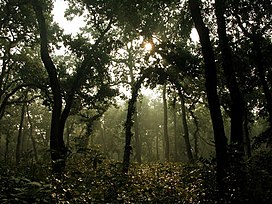
Back Boscos subtropicals de frondoses de l'Himàlaia Catalan Himalajaj subtropikaj foliarbaroj Esperanto جنگلهای پهنبرگ جنبحارهای هیمالیا Persian हिमालय उपोष्ण पृथुपर्णी वन Hindi Foreste di latifoglie subtropicali dell'Himalaya Italian Гималайские субтропические широколиственные леса Russian Гімалайські субтропічні широколисті ліси Ukrainian
| Himalayan subtropical broadleaf forests | |
|---|---|
 Sal forest in Chitwan National Park | |
 Ecoregion territory (in purple) | |
| Ecology | |
| Realm | Indomalayan |
| Biome | tropical and subtropical moist broadleaf forests |
| Borders | |
| Bird species | 343[1] |
| Mammal species | 148[1] |
| Geography | |
| Area | 38,200 km2 (14,700 sq mi) |
| Countries | |
| Conservation | |
| Habitat loss | 81.553%[1] |
| Protected | 6.77%[1] |
The Himalayan subtropical broadleaf forests is an ecoregion that extends from the middle hills of central Nepal through Darjeeling into Bhutan and also into the Indian States of Uttar Pradesh and Bihar. It represents the east–west-directed band of subtropical broadleaf forest at an altitude of between 500 and 1,000 m (1,600 and 3,300 ft) along the Outer Himalayan Range, and includes several forest types traversing an east to west moisture gradient.[2]
- ^ a b c d Hoekstra, J. M.; Molnar, J. L.; Jennings, M.; Revenga, C.; Spalding, M. D.; Boucher, T. M.; Robertson, J. C.; Heibel, T. J.; Ellison, K. (2010). Molnar, J. L. (ed.). The Atlas of Global Conservation: Changes, Challenges, and Opportunities to Make a Difference. University of California Press. ISBN 978-0-520-26256-0.
- ^ Rawat, G. S., Wikramanayake, E. D. (2002) Himalayan subtropical broadleaf forests In: Wikramanayake, E. D. (ed.) Terrestrial ecoregions of the Indo-Pacific: a conservation assessment. Island Press